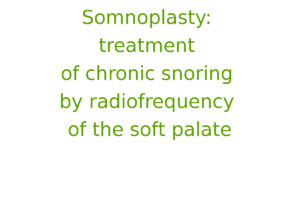Hospital Ruber Internacional. Madrid
The goal of this study is to evaluate the efficacy and the safety of tissue reduction of the palate by means of radiofrequency for the treatment of snoring.
Fifty-three patients were evaluated. Eight of them (15%) met criteria for mild OSAS. All of them underwent RF energy treatment with several ablation sites and the mean total energy administered was about 2500 J per treatment session. 40 patients (75%) underwent an additional RF treatment and the energy administered in the second session was the same as in the first one. We evaluated postoperative pain, snoring and the satisfaction of the patient and his enviroment. After a mean follow-up of 20 months no adverse effect was repported.
The success diminishes with time as happens other surgical procedures (UPPP or LAUP) but the absence of serious adverse side-effects and the minimal postoperative pain support the use of RF as an effective procedure for reducing snoring.
The original text taken from a:
![]() http://www.sciencedirect.com/science/article/pii/S0001651903784684
http://www.sciencedirect.com/science/article/pii/S0001651903784684
A N Galindo Campillo, M Garcías Imal, M Navarro Cunchillos, A Toledano Muñoz, Somnoplastia: tratamiento del ronquido crónico mediante radiofrecuencia sobre el paladar, Acta Otorrinolaringol Esp. 2003;54:686-92.
Translations
| The article "Somnoplasty: treatment of chronic snoring by radiofrequency of the soft palate" in other languages | |
|---|---|
| Somnoplastia: tratamiento del ronquido crónico mediante radiofrecuencia sobre el paladar (A.N. Galindo Campillo, M. García Simal, M. Navarro Cunchillos, A. Toledano Muñoz) Español: Somnoplastia: tratamiento del ronquido crónico mediante radiofrecuencia sobre el paladar Hospital Ruber Internacional. Madrid |  |










